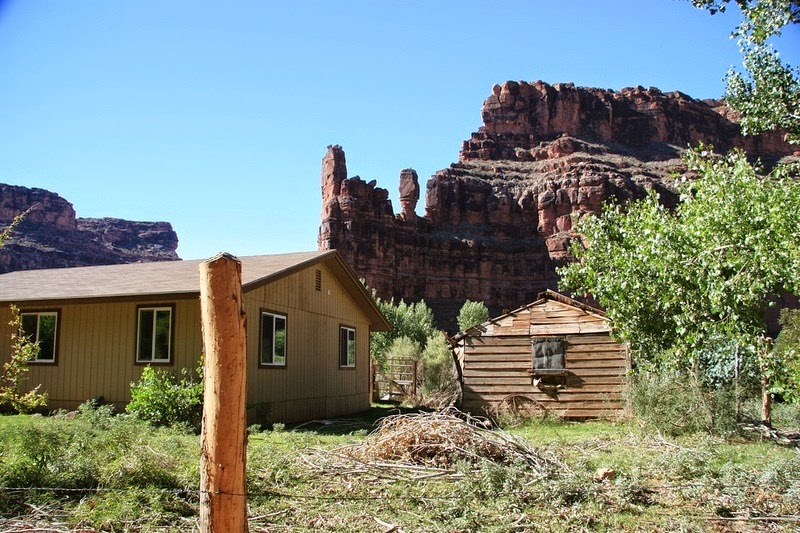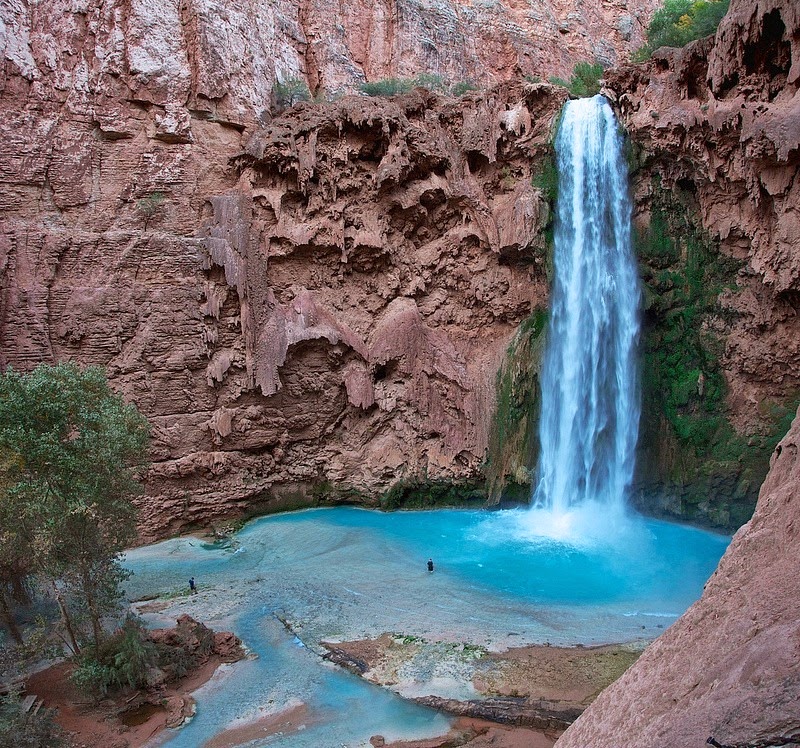Despite being one of the most visited places in the United States, the Grand Canyon area in Arizona, still holds secrets. One of these is the Indian village of Supai located at the bottom of Havasu Canyon also known as Cataract Canyon, a side branch of the Grand Canyon, on the Havasupai Nation reservation. Home to the Havasupai tribe who have been living in the Grand Canyon for at least the past 800 years, Supai is perhaps the most isolated village in the United States. Although its just 13 km from the nearest road, no cars can reach it. The only way to get to it is to take a helicopter or to hike or ride a mule along the Havasupai Trail. Supai is the only place in the United States where mail is still carried out by mules.
Havasupai means "people of the blue-green waters." The name comes from vibrant blue-green waters of Havasu Creek as it flows through Havasu Canyon and through Supai until it flows into the Colorado River. The Havasupai tribe is the smallest Indian Nation in America totaling about 600 people. Before the arrival of Europeans, this Yuman-speaking population once laid claim to an area the size of Delaware. They farmed the land where the canyon widened and the plentiful waters of Havasu Creek allowed them grow corn, squash, melons and beans. After harvest when the winter set it, they moved to the rim of the canyon where men hunted deer, antelope and small game and women made beautiful baskets.
This idyllic lifestyle was interrupted by the arrival of miners and ranchers in the early 19th century who seized their lands and restricted them to a small reservation in the canyon. A silver rush and the Santa Fe Railroad practically destroyed the fertile land. Furthermore, the inception of the Grand Canyon as a national park in 1919 pushed the Havasupai to the brink, as their land was consistently being used by the National Park Service. It wasn’t until 1975, after nearly a century of fighting through the US judicial system, that the government restored their ancestral land.
Today, the Havasupai people continue to cultivate their crops and weave baskets but their primary source of revenue is through tourism. Each year more than 20,000 visitors hike their way to the village that falls on the way to the spectacular waterfalls of Havasu Canyon. The village has numerous businesses catering to tourists such as a café, a couple of general stores, a lodge and a post office from where one can mail post cards. The village also has a school, an LDS chapel, and a small Christian Church, among other buildings.
The Havasupai Trail. Photo credit
Mule Train to Supai. Photo credit
Supai, the village hidden inside the Grand Canyon. Photo credit
The church. Photo credit
A general store. Photo credit

Visitor lodge in Supai. Photo credit
The Supai cafe. Photo credit
The Waterfalls of Havasu Canyon
Havasu Creek forms numerous waterfalls as it runs through Havasu Canyon. The small trickle of snow run-off and rain water that the Havasu Creek starts out as becomes a force when it is joined by the waters of the underground Havasu Springs. The creek is well known for its blue-green color and distinctive travertine formations due to large amounts of calcium carbonate in the water. The waters plunge over Navajo Falls, Havasu Falls, Mooney Falls, Beaver Falls and numerous others on the way to the Colorado River about ten miles away from Supai Village.
Havasu Falls, the main attraction inside Havasu Canyon. The falls are known for their natural pools, created by mineralization. Photo credit
Havasu Falls from a different angle. Photo credit
Havasu Falls. Photo credit

Mooney Falls. Photo credit
Mooney Falls. Photo credit
Girl jumping off one of the waterfalls created after the 2008 flash flood in Havasupai Reservation. Photo credit
Rock Falls in the foreground and New Navajo Falls in the background. Photo credit
Source: Wikipedia / Desert USA / Great Adventures



























amazing
ReplyDeleteSeriously have you never heard of Alaska?? ?ay Barrow or Diomede
ReplyDeleteLower 48 is the claim to Supai's remote; we are all sure Alaska wins over all.50, no worries!
DeleteVillage of Supai looks just perfect place for me to live.
ReplyDeleteI have seen the deep dark horror off these people. Just look up Havasupai Equines.. http://ireport.cnn.com/docs/DOC-330750.. https://www.tripadvisor.com/ShowUserReviews-g143028-d126794-r132562950-Havasupai_Falls-Grand_Canyon_National_Park_Arizona.htmlhttps://www.youtube.com/watch?v=9Ngm0HYII2k
ReplyDeleteI Felt the same way when I visited their 2009. I often wonder what it would be like to go back and document what's happening there, I think it's significant. Thanks for info
DeleteIt's horrifying that these people were relegated to a small hole by colonialists. But an LDS chapel and Christian Church is almost unforgivable. I better go operate a Starbucks out of a yurt before the tourists arrive.
ReplyDeleteAmazing place that reminds me of certain ancient sites of the Holy Land in The Middle East like Wadi Mujib ( Mujib Canyon ) in Jordan which I visited in 1998, is also isolated place with falls penetrating the High colorful rocks. The difference is that Suvai is still inhabited oppose to the Mujib with no man's land.
ReplyDeleteThere is a travel trailer in Supai village. Does anyone know how it go there. It has clearly been there for a long time.
ReplyDelete